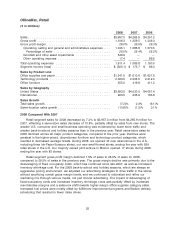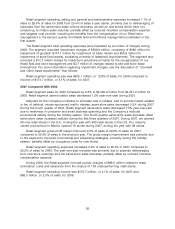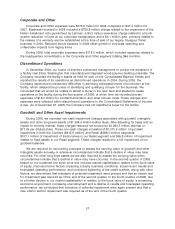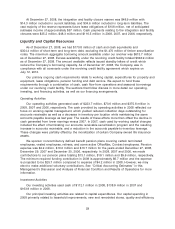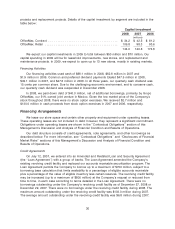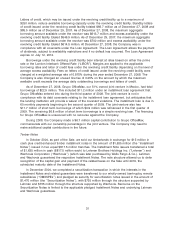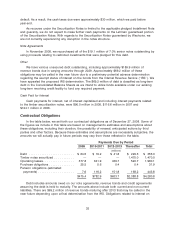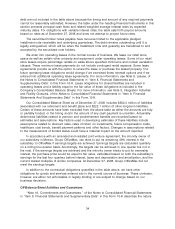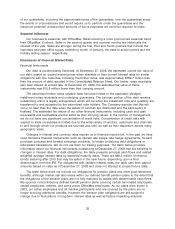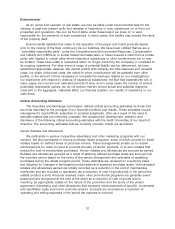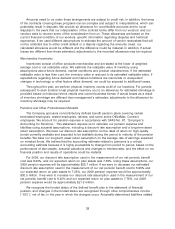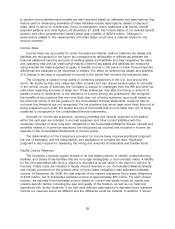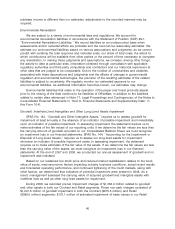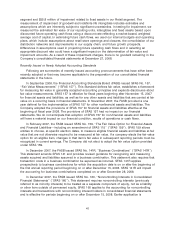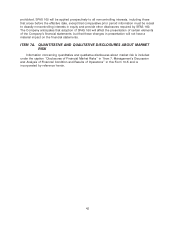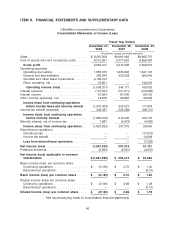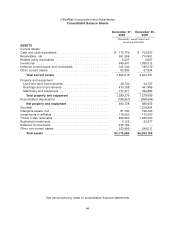OfficeMax 2008 Annual Report Download - page 39
Download and view the complete annual report
Please find page 39 of the 2008 OfficeMax annual report below. You can navigate through the pages in the report by either clicking on the pages listed below, or by using the keyword search tool below to find specific information within the annual report.of our guarantees, including the approximate terms of the guarantees, how the guarantees arose,
the events or circumstances that would require us to perform under the guarantees and the
maximum potential undiscounted amounts of future payments we could be required to make.
Seasonal Influences
Our business is seasonal, with OfficeMax, Retail showing a more pronounced seasonal trend
than OfficeMax, Contract. Sales in the second quarter and summer months are historically the
slowest of the year. Sales are stronger during the first, third and fourth quarters that include the
important new-year office supply restocking month of January, the back-to-school period and the
holiday selling season, respectively.
Disclosures of Financial Market Risks
Financial Instruments
Our debt is predominantly fixed-rate. At December 27, 2008, the estimated current fair value of
our debt, based on quoted market prices when available or then-current interest rates for similar
obligations with like maturities, including the timber notes, was approximately $769.7 million less
than the amount of debt reported in the Consolidated Balance Sheet. Our timber notes receivable
also bear interest at a fixed rate. At December 27, 2008, the estimated fair value of these
instruments was $15.6 million lower than their carrying amount.
The securitized timber notes payable have recourse limited to the applicable pledged
installment notes receivable and underlying guarantees. The Lehman portion of the debt remains
outstanding until it is legally extinguished, which will be when the installment note and guaranty are
transferred to and accepted by the securitized note holders. The Company expects that this will
occur no later than the date when the assets of Lehman are distributed and the bankruptcy is
finalized. The estimated fair values of our other financial instruments, including cash and cash
equivalents and receivables are the same as their carrying values. In the opinion of management,
we do not have any significant concentration of credit risks. Concentration of credit risks with
respect to trade receivables is limited due to the wide variety of vendors, customers and channels
to and through which our products are sourced and sold, as well as their dispersion across many
geographic areas.
Changes in interest and currency rates expose us to financial market risk. In the past we have
used derivative financial instruments, such as interest rate swaps, rate hedge agreements, forward
purchase contracts and forward exchange contracts, to hedge underlying debt obligations or
anticipated transactions. We do not use them for trading purposes. The table below provides
information about our financial instruments outstanding at December 27, 2008 that are sensitive to
changes in interest rates. For debt obligations, the table presents principal cash flows and related
weighted average interest rates by expected maturity dates. There are $69.2 million of revenue
bonds maturing after 2013 that may be called in the near future, depending upon a final
determination from the IRS. For obligations with variable interest rates, the table sets forth payout
amounts based on rates as of December 27, 2008 and does not attempt to project future rates.
The table below does not include our obligations for pension plans and other post retirement
benefits, although market risk also arises within our defined benefit pension plans to the extent that
the obligations of the pension plans are not fully matched by assets with determinable cash flows.
We sponsor noncontributory defined benefit pension plans covering certain terminated employees,
vested employees, retirees, and some active OfficeMax employees. As our plans were frozen in
2003, our active employees and all inactive participants who are covered by the plans are no
longer accruing additional benefits. However, the pension plan obligations are still subject to
change due to fluctuations in long-term interest rates as well as factors impacting actuarial
35


